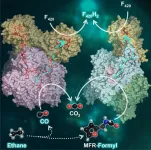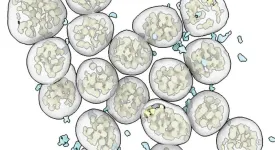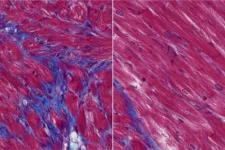(Press-News.org) An international research team led by NYU Tandon School of Engineering and KAIST (Korea Advanced Institute of Science and Technology) has pioneered a new technique to identify and characterize atomic-scale defects in hexagonal boron nitride (hBN), a two-dimensional (2D) material often dubbed "white graphene" for its remarkable properties.
This advance could accelerate the development of next-generation electronics and quantum technologies.
The team reported that it was able to detect the presence of individual carbon atoms replacing boron atoms in hBN crystals. This discovery was made possible by listening to the electronic "noise" in specially designed transistors, akin to hearing a whisper in a quiet room.
ACS Nano selected the research paper as its cover story for the October 22, 2024 edition.
"In this project, we essentially created a stethoscope for 2D materials," said Davood Shahrjerdi, one of the paper's corresponding authors along with Yong-Hoon Kim. "By analyzing the tiny and rhythmic fluctuations in electrical current, we can 'perceive' the behavior of single atomic defects."
Shahrjerdi is an associate professor in NYU Tandon’s Electrical and Computer Engineering Department, a faculty member of NYU WIRELESS, and the Director of the NYU Nanofabrication Cleanroom (NanoFab) that opened in 2023. Kim is Professor of Electrical Engineering at KAIST. Shahrjerdi and Kim are also affiliated faculty at NYU-KAIST Global Innovation and Research Institute where they lead collaborations in the NYU-KAIST Next-Gen Semiconductor Devices and Chips research group.
The NYU-KAIST partnership was officially launched at NYU in September 2022 by the President of South Korea. This historic partnership combines the distinctive strengths of both universities to drive advances in research and education and currently involves over 200 faculty from both institutions.
Single-crystal hBN has emerged as a wonder material in scientific circles, promising to transform fields from unconventional electronics to quantum technologies.
hBN’s atomically thin structure and excellent insulating properties make it an ideal medium for hosting exotic physical phenomena that are not possible with conventional materials. The atomic defects in hBN can degrade its electronic properties, sometimes in ways that could be harnessed for quantum technologies.
The NYU team built a transistor using a few-layer thin molybdenum disulfide (another 2D semiconducting material) sandwiched between layers of hBN. By cooling this device to cryogenic temperatures and applying precise electrical voltages, they were able to observe discrete jumps in the current flowing through the transistor.
These jumps, known as random telegraph signals (RTS), occur when electrons are captured and released by defects in the hBN. By carefully analyzing these signals at different temperatures and voltages, the team was able to determine the energy levels and spatial locations of the defects.
"It's like we've developed a microscope that can 'see' individual atoms, but instead of light, we're using electricity," said Zhujun Huang, the paper’s first author who was an NYU Tandon ECE Ph.D. student at the time of the study.
The KAIST team then used advanced computer simulations to clarify the atomistic origins of the experimental observations. Specifically, this combination of experiment and theory revealed that the defects are carbon atoms sitting in places where boron atoms should be in the hBN crystal structure.
"Understanding and controlling the defects in 2D materials could have significant implications for the future of electronics and quantum technologies," explained Sharhrjerdi and Kim. "For example, we might be able to create more perfect quantum material platforms for discovery of new physics or single-photon emitters for secure communications."
This work adds to NYU Tandon's expanding portfolio in quantum materials and device technologies, aligning with the CHIPS and Science Act's semiconductor innovation goals. Prior research demonstrated nanomanufacturing principles for low-disorder quantum materials and their potential in devices when integrated with superconductors. The NYU Nanofab, a prototyping facility within the Northeast Regional Defense Technology Hub (NORDTECH), one of eight Microelectronics (ME) Commons hubs in the U.S., further advances the field. The Nanofab specializes in quantum materials and devices integration, serving NYU and regional research communities.
In addition to Shahrjerdi, Kim and Huang, the paper’s authors are Ryong-Gyu Lee, Jiyoon Song, and Jeongwon Lee, all from the School of Electrical Engineering at KAIST; Edoardo Cuniberto and Abdullah Alharbi, both Ph.D. alumni at NYU Tandon’s ECE Department; Kim Kisslinger from the Center for Functional Nanomaterials at Brookhaven National Laboratory; Takashi Taniguchi from the Research Center for Materials Nanoarchitectonics at the National Institute for Materials Science in Tsukuba, Japan; and Kenji Watanabe from the Research Center for Electronic and Optical Materials, also at the National Institute for Materials Science in Tsukuba, Japan.
In the United States, support for the research came from the National Science Foundation and the U.S. Department of Energy's Center for Functional Nanomaterials at Brookhaven National Laboratory. South Korean contributions included multiple grants from the National Research Foundation of Korea, the BK21 Plus program at KAIST, and computational resources from the KISTI Supercomputing Center. Japanese support was provided by the Japan Society for the Promotion of Science (JSPS) KAKENHI and the World Premier International Research Center Initiative (WPI) of MEXT.
END
Researchers at NYU Tandon School of Engineering and KAIST develop method to 'hear' defects in promising nanomaterial
2024-10-23
ELSE PRESS RELEASES FROM THIS DATE:
Biodiversity increases nutrient availability
2024-10-23
Animals not only need sufficient calories to function, but also essential nutrients — including omega-3 and omega-6 polyunsaturated fatty acids (PUFA). Insects and arachnids are an important source of these essential fatty acids for birds, hedgehogs, lizards and the like. However, the content depends on the specific types of insects and spiders consumed. Aquatic insects, such as caddisflies or dragonflies, contain significantly more omega-3 long-chain (LC) PUFA than terrestrial insects because omega-3- LC-PUFA rich algae form the base of the food chain in aquatic ecosystems.
The ...
American Society of Anesthesiologists names Donald E. Arnold, M.D., FACHE, FASA, new president
2024-10-23
PHILADELPHIA — Donald E. Arnold, M.D., FACHE, FASA, chair of the Department of Anesthesiology, Mercy Hospital in St. Louis and member of the board of directors of Western Anesthesiology Associates, Inc., in Ballwin, Missouri, was today named president of the American Society of Anesthesiologists (ASA), the nation’s largest organization of anesthesiologists. Dr. Arnold assumed office at the ANESTHESIOLOGY® 2024 annual meeting and will serve for one year.
“I’m honored to be named president of ASA and committed to serving our members, supporting the Society’s mission to advance the specialty, preserving physician-led anesthesia care, and above ...
Family as a wealth factor
2024-10-23
Wealth is one of the strongest indicators of social status, acting as a key indicator of social inequality and influencing access to education, health care and professional success. In a study, researchers from the Max Planck Institute for Demographic Research, the University of Cologne, GESIS and the Norwegian Institute of Public Health examined how financial wealth changes related to various generational transitions within families. The study used data from Norwegian registries and focused on people born in 1953.
Investigating changes in wealth within the ...
Breathing deep: A metabolic secret of ethane-consuming archaea unraveled
2024-10-23
Seeps on the deep seafloor naturally emit alkanes, which are pollutants that are potentially dangerous to life and act on global warming. Fortunately, the sediments around the seeps host microbes that act as a biological filter: They consume most of the alkanes before their release into the oceans and our atmosphere. This so-called anaerobic oxidation of alkanes is an important yet poorly understood microbial process. Scientists from the Max Planck Institute for Marine Microbiology in Bremen, Germany, now ...
NIH clinical trial will test precision medicine treatments for myeloid cancers
2024-10-23
The National Institutes of Health (NIH) has launched a proof-of-concept precision medicine clinical trial to test new treatment combinations targeting specific genetic changes in the cancer cells of people with acute myeloid leukemia (AML) and myelodysplastic syndromes (MDS). The trial, funded by NIH’s National Cancer Institute (NCI), aims to accelerate the discovery of more tailored treatments for these aggressive cancers of the blood and bone marrow.
“AML and MDS are a heterogeneous group of cancers that can progress very quickly. Treatment advances depend in part on the ability to rapidly identify which subtype of cancer each patient has so that treatments can be tested for ...
Novel antibody platform tackles viral mutations
2024-10-23
New York, NY, October 23, 2024 — Scientists at the Icahn School of Medicine at Mount Sinai, in collaboration with colleagues in the field, have developed an innovative antibody platform aimed at tackling one of the greatest challenges in treating rapidly evolving viruses like SARS-CoV-2: their ability to mutate and evade existing vaccines and therapies.
Their findings, including preclinical studies in mice, introduce the Adaptive Multi-Epitope Targeting and Avidity-Enhanced (AMETA) Nanobody Platform, a new antibody approach for addressing how viruses like SARS-CoV-2, which causes COVID-19, evolve to evade vaccines and treatments. Details on the results were published October 23 ...
myeloMATCH precision medicine trials in myeloid leukemias open to patient enrollment across US and Canada
2024-10-23
Four leading cancer research organizations in the United States and Canada announce the opening of patient enrollment to myeloMATCH, a unique portfolio of clinical trials to test precision medicine treatments for adults with acute myeloid leukemia (AML) or myelodysplastic syndrome (MDS).
The Alliance for Clinical Trials in Oncology, Canadian Cancer Trials Group, ECOG-ACRIN Cancer Research Group, and SWOG Cancer Research Network are collaborating within the National Cancer Institute (NCI) National Clinical Trials Network (NCTN) to design and lead the trials. They expect to open ...
Social determinants of health and US health care expenditures by insurer
2024-10-23
About The Study: In this cross-sectional study of 14,000 insured adults, individual-level social determinants of health were significantly associated with U.S. health care expenditures by Medicare, Medicaid, and private insurers. These findings may inform health insurers and policymakers to incorporate social determinants of health in their decision-making practices to identify and control health care expenditures, advancing health equity.
Corresponding Author: To contact the corresponding author, Giridhar Mohan, MPH, email gmohan1@jhu.edu.
To access the embargoed study: Visit our For The Media website at this link https://media.jamanetwork.com/
(doi:10.1001/jamanetworkopen.2024.40467)
Editor’s ...
Traumatic and adverse childhood experiences and developmental differences in psychiatric risk
2024-10-23
About The Study: In this cohort study, distinct forms of traumatic and adverse childhood experiences differentially moderated developmental changes in psychiatric risk and cognitive ability in different ways, offering the possibility for precision-based prediction of risk for youth. Such findings could be used in targeted early prevention and intervention strategies for at-risk youth.
Corresponding Author: To contact the corresponding author, Justin D. Russell, PhD, email jdrussell3@wisc.edu
To access the embargoed study: Visit our For The Media website at this link https://media.jamanetwork.com/
(10.1001/jamapsychiatry.2024.3231)
Editor’s ...
Immunotherapy blocks scarring, improves heart function in mice with heart failure
2024-10-23
A new study from Washington University School of Medicine in St. Louis suggests that a type of immunotherapy — similar to that approved by the Food and Drug Administration (FDA) to treat inflammatory conditions such as arthritis — also may be an effective treatment strategy for heart failure.
The study is published Oct. 23 in the journal Nature.
After a heart attack, viral infection or other injury to the heart, scar tissue often forms in the heart muscle, where it interferes with the heart’s normal contractions and plays a leading role in heart failure, the progressive loss of the heart’s ...



